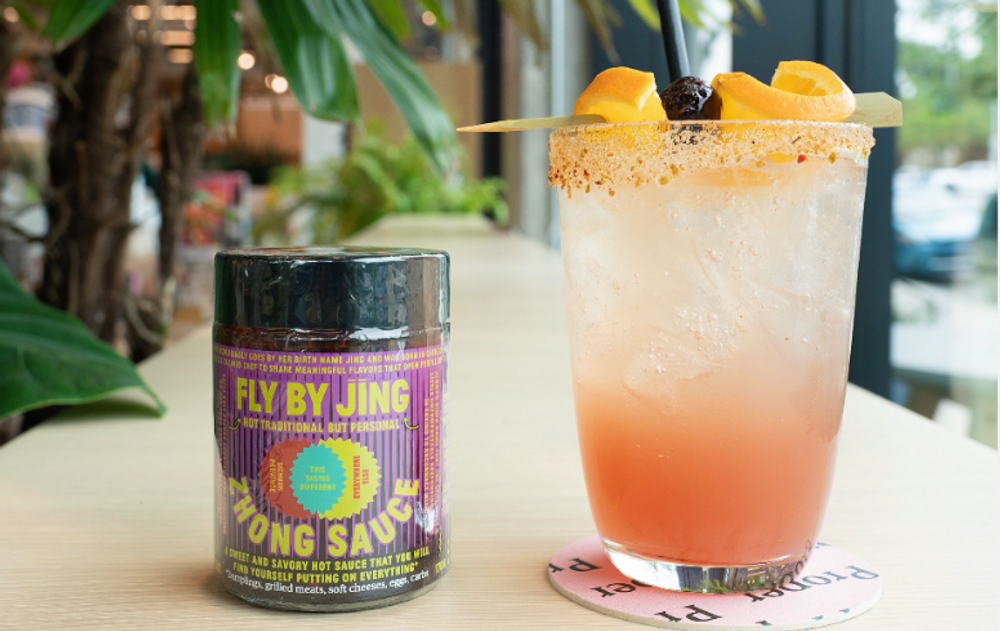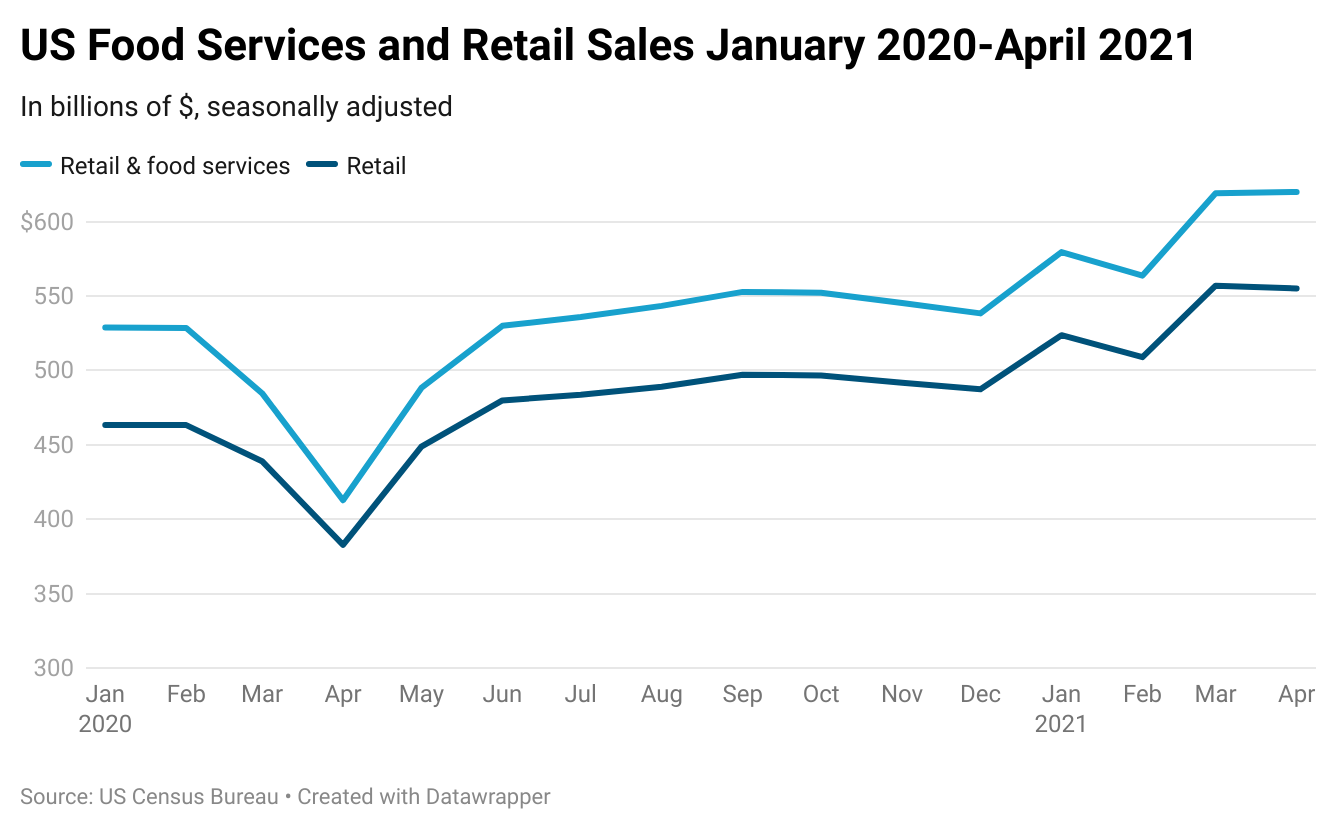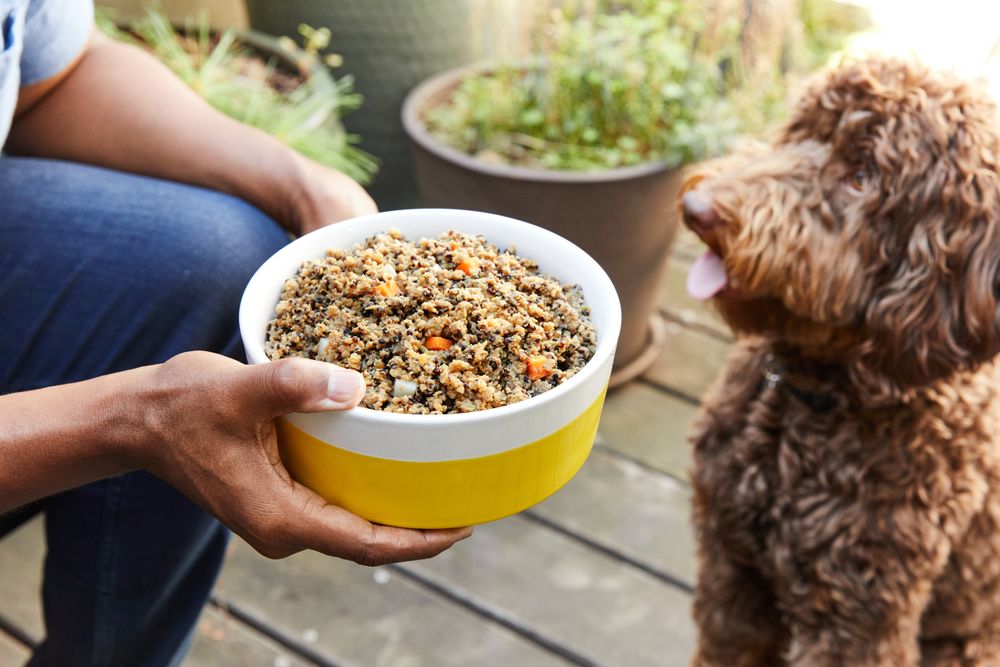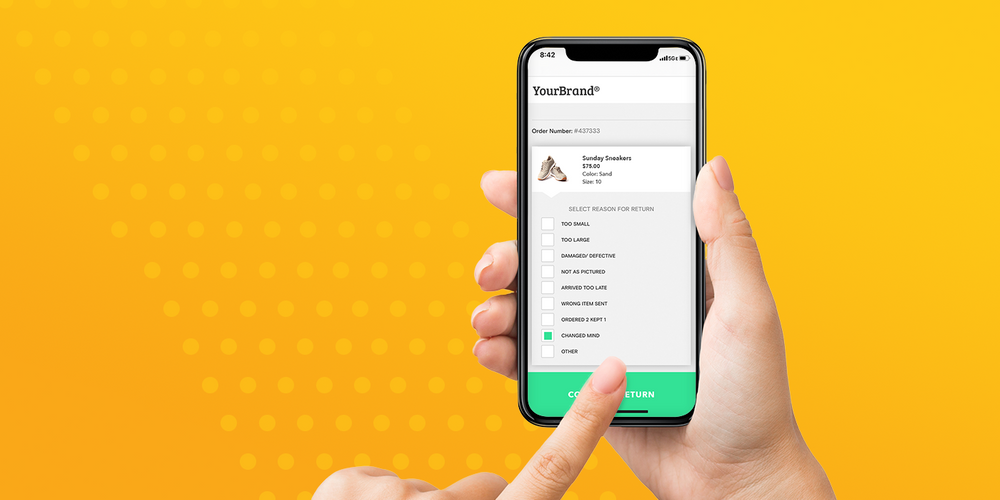|
Good afternoon. Social calendar still not back to pre-pandemic levels? You can sit with us on the earnings wires. Macy’s, L Brands, Kohl’s, and VF Corp all report their quarterly earnings this week.
Watch for increasing dressy apparel sales, decreasing athleisure pivots, and plateauing “You’re on mute” moments.
In today’s edition:
- Indie CPGs on the menu
- April retail sales recap
- General Mills buys Tyson's pet treat biz
— Halie LeSavage, Katishi Maake
|
|

Courtesy of Neighborhood Goods
|
When DTC food and beverage brands develop an appetite for wholesale, their journeys usually start on Whole Foods or Target shelves.
Not for these brands: Haus (aperitifs), Fly By Jing (sauces), and Parlor Coffee (self-explanatory) are thinking outside the store to entice new customers, appearing on restaurant menus as featured ingredients. It’s part marketing ploy, part interactive experience.
Restaurant locator: The brands above are starting small, with one-off or limited partnerships.
- Fly By Jing and Parlor Coffee joined cocktails and entrées at Neighborhood Goods’s in-store restaurant in Austin, TX, this month. Matt Alexander, Neighborhood Goods’s cofounder, told Retail Brew diners can scan a menu QR code to shop the featured items from their table.
- After experimenting with cocktails at two California restaurants earlier this spring, Haus is “signing contracts with restaurants all over” the state, cofounder Helena Price Hambrecht told us.
At least one player is getting more ambitious. Nuggs, the plant-based “chicken” nugget brand, previously told Retail Brew it’s pursuing quick-service partnerships. COO Sam Terris declined to share exactly where or when Nuggs will join menus, in a follow-up.
Play with your food
For digitally native CPG brands, appearing on the menu is one form of meeting a familiar goal: expanding beyond online buyers. “Getting on a shelf in a major grocery store is great, but those are the spaces characterized by a huge amount of competition,” Alexander said. “It's hard to really have that moment of discovery.”
With kitchen creatives mixing ingredients, shoppers can “meet” brands in a new context—one more likely to reflect their personality.
- All three CPG companies have given restaurant teams full license to use their items however they want. It’s a taste test and a product demo in one.
- Price Hambrecht said these placements have already inspired halo purchases: “Customers through wholesale can try the particular flavor that the restaurant has, but they could always come back to our website as well for all our additional flavors.”
Why not nationwide? It’s a matter of resources, according to Kat Cole, former COO and president of Focus Brands. Brands like Oreo or M&Ms have more than name recognition on their side. Showing up as a milkshake topping in hundreds of restaurants often comes with enormous distribution requirements and lofty insurance fees—beyond what even the most Instagram-famous indie CPG brand can typically afford, Cole explained.
Looking ahead...CPG brands still see expansion opportunities, even if they can’t yet scale to coast-to-coast chains.
- Alexander told us there are plans for additional Neighborhood Goods locations to create DTC-infused menus.
- Price Hambrecht said Haus aims to enter restaurants beyond its home market after its California rollout. — HL
|
|
|
Yes, US retail sales were flat in April, holding steady at just under $620 billion. But no need to sound the alarm.

Glenda Toma
Consider this: March was madness, with US retail sales up 10.7%—the largest gain in 10 months, thanks to stimulus checks, state reopenings, and a steady rollout of vaccines. The fact that April didn’t deliver similar numbers month over month wasn’t a surprise to Sucharita Kodali, principal analyst at Forrester.
- “What I would expect to see is a much stronger April over last year, and something that’s comparable to two years ago,” she told Retail Brew. “That data is far more useful since it gives a better sense of the overall recovery trajectory,” she added.
Let’s measure: April retail sales were up 51.2% YoY, which Kodali said is a sign of “normalization.”
- On a YoY basis, all sectors tracked by the US Commerce Department—except food and beverage stores—experienced growth.
- Apparel and restaurants saw significant increases, at 726.8% and 116.8% from April 2020, respectively.
- Food and beverage, which includes grocers and alcohol distributors, brought in roughly $71 million in sales in April, about the same as last year.
One more thing: There’s still plenty of demand ahead, Kodali told us, given that states like California haven’t completely lifted lockdown restrictions.
“[Restaurants] will be open just in time for summer,” she said. “The ones that have survived are going to see more demand than they will probably ever see.” — KM
|
|

|
It also happens to be the number of messages Listrak analyzed to compile its 2021 Ecommerce Email Benchmark Report. Sev-en-ty BILLION.
Whew, let’s back up for a second. Listrak is the cutting-edge integrated marketing platform built specifically to drive results for retailers—in other words, they know a thing or two when it comes to increasing engagement, revenue, and loyalty at every point of interaction.
So what’s in this report? Think benchmark results for 70,000,000,000 emails sent by 1,000+ retailers and brands across 11 different types of email campaigns in 2020.
Listrak didn’t just hoover up the data on email campaign metrics, either; they broke them down into key findings, such as:
- Increased send volumes don’t degrade engagement rates
- Personalized product recommendations increase conversions
- A single integrated platform is crucial
Want more insights based on a rather large number of marketing emails? Get Listrak’s 2021 Ecommerce Email Benchmark Report here.
|
|

Courtesy of Pet Plate
|
General Mills’s latest acquisition is all bite. The consumer foods heavyweight agreed to buy Tyson Foods’s pet treat business for a cool $1.2 billion in cash.
The deets: Under the deal, General Mills will own the Nudges, Top Chews, and True Chews brands, expanding a portfolio that already includes Blue Buffalo, which it bought for $8 billion in 2018.
- Tysons Foods’s pet business delivered $240+ million in sales over the 12-month period ending April 3.
- General Mills’s pet segment grew in each of its last four quarters, most recently by 14% to $436 million. Net sales hit $1.29 billion over the nine months ending Feb 28.
The why: Pet adoptions exploded during quarantine. And pet food and treat sales increased 9.7% in 2020 to $42 billion, according to the American Pet Products Association. General Mills doesn’t see things slowing down.
- “Pet food is a high-growth category, fueled by the humanization of pets, a trend that has only increased during the pandemic,” Bethany Quam, group president of General Mills’s pet segment, said in a statement.
- On the other hand, there’s the sad reality that some pandemic pets are being returned as workplaces reopen.
Zoom out: Competition in the pet space is heating up. Petco invested $300 million in its digital ops, and reseller Poshmark launched a pet category in February. — KM
|
|
-
J.Crew appointed a new menswear designer: Brendon Babenzien, a streetwear veteran.
-
Amazon created a workplace safety program that includes stretching exercises and meditation.
-
Zara is developing a video game with Facebook to advertise its Pull&Bear brand.
-
Coke is discontinuing its Coke Energy drink, which debuted in January 2020.
-
Bain predicts global luxury sales are headed for a post-Covid rebound.
|
|

|
Pleasant returns = loyal customers. Seems counterintuitive, but providing your customers with a great experience when they wanna return an item will lead to more business in the long run. Why? Cuz consumers are looking for retailers to provide lots of choices throughout every aspect of their experience. To learn how to turn customers into loyalists through enhanced returns experiences, read Optoro’s data report here.
|
|
|
Last week, the CDC updated its guidance so that fully vaccinated people are no longer required to wear masks indoors or outdoors, regardless of crowd size.
- Starbucks updated its policy along those lines, allowing fully vaccinated people to go maskless inside their cafes, unless required to by local or state law. Walmart, Target, Trader Joe’s, and Costco have taken similar approaches.
- Home Depot, Gap, and Ulta, meanwhile, are leaving their mask policies in place—for now.
Hot or not? How should retailers approach their mask policies, given the CDC’s new guidance? Cast your vote here.
Circling back: Last Monday, we asked if livestream shopping has a future in the US post-pandemic. More than two thirds (68%) believe it does, while 32% either don’t believe so or aren’t sure.
|
|
|
Today’s top retail longreads.
Double shot, caramel pump, extra foam: Starbucks lets shoppers edit their drinks to a near-endless degree on its app. Add in viral drink recipe suggestions from TikTok, and filling orders is more complicated than ever. (BuzzFeed News)
What to expect: From clinics to care products, new startups want to reinvent pregnancy care. (Fast Company)
Tailor-made: Made-to-order production models have given some brands sustainability cred, for cutting down on materials waste. For plus-size shoppers, made-to-order is also an avenue to access styles that aren’t typically available in larger sizes. (Refinery29)
|
|
|
Catch up on the Retail Brew stories you may have missed.
|
|
|
Written by
Halie LeSavage and Katishi Maake
Was this email forwarded to you? Sign up here.
|
ADVERTISE // CAREERS // SHOP // FAQ
Update your email preferences or unsubscribe here.
View our privacy policy here.
Copyright © 2021 Morning Brew. All rights reserved.
22 W 19th St, 8th Floor, New York, NY 10011
|
|









